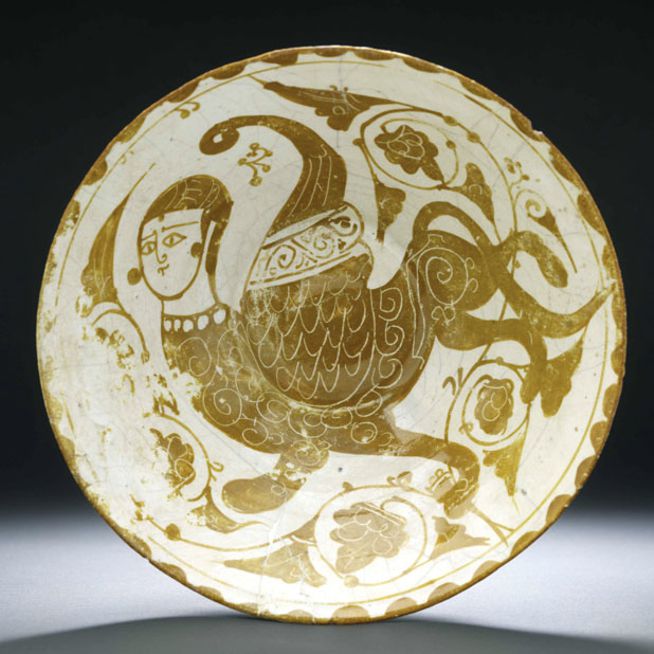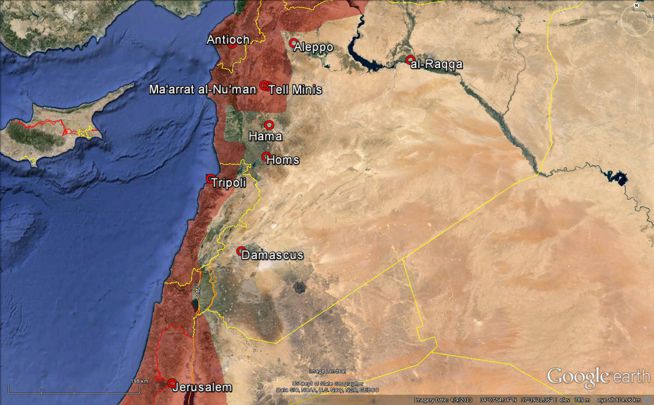My Favourite Object: A "Tell Minis" Style Lustre-Ware Bowl
Posted: March 28, 2015 - 13:12 , by Robert Mason
Categories:
World Culture |
Comments () | Comment
This beautiful bowl, ROM Accession number 960.219.2, was made in Syria between about AD 1075-1125, and if you read this story, you will find out why I would really like to meet the person that made it.

The first thing you notice about this bowl is its decoration. It looks lile a sphinx, a mythical beast more popularly associated with the sphinx at Giza, Egypt. It was permitted to depict mythical beasts in Islamic law, whereas depictions of humans or animals were considered close to idolatry. Objects with images of people were known, including on pottery just like this, but this vessel might have been made for someone who followed the rules more strictly. However, of all the creatures I have seen on the pottery of the Islamic world, this, together with a human-headed bird are by far the most common, any other being practically unknown. Ancient mythical creatures are far more diverse, and it is very strange that only these creatures were copied. If we look at the origins of this creature, it is of interest to note that they were originally guardians of holy and other important places, such as palaces, and indeed modern scholarship would see the cherubim which guarded the Temple in Jerusalem as depictions of these creatures. Eventually the artists of the Islamic world stopped depicting these creatures, as they become old-fashioned compared to imported Chinese motifs like dragons, so we may never know what is actually being depicted.
The second thing you might notice is how it is decorated. It has a strange metallic paint on it which reflects light as though it were gold. This is lustre-paint, and from about AD 800 to 1300 lustre-painted pottery represented the highest achievements in ceramic art in the Middle East. It was probably a secret technique, developed by alchemists during the 8th century AD in the great cities of Iraq like Baghdad and Basra. Here scientists and books were brought from all over the world and here their knowledge was synthesized, developed and refined. Lustre-paint is an amalgam of copper, silver, iron oxides, an earthy medium and gum, which is painted onto the surface of an already made and fired vessel. It is then heated again in a special kiln that only heats the pot until the precious metals fuse to the surface. If the kiln is too cool, the metals will not fuse to the glaze; if too hot, the entire paint, including the earth and iron-oxides, will fuse to the surface. If too much oxygen gets into the kiln, it will vaporize the precious metals, if not enough, the pot will turn black.

I have undertaken a great deal of research on lustre-wares, using archaeological techniques to date them, techniques taken from geology to say where they are made, and using scanning-electron microscopes to see how the wares were made. I know that from about AD 800-975 lustre wares were only made at one place in the world: Basra in southern Iraq. This was the period of the legendary Sindbad, and the pottery made in Basra has been found at the furthest limits of the Old World. During this time the potters developed a technique to put tin in the glaze, making it opaque and white. This tin-glaze technology was later taken to Europe where it was used to make wares like Majolica and Delft. In about AD 975 they stopped making lustre-wares in Basra and started making it in Fustat, the older part of Cairo, in Egypt. I think it was the same potters who had moved, because the high-technology lustre-paint and tin-glazes could not be copied. For one hundred years the only lustre-wares in the world were made in Fustat, many of which were sent to Europe. During this time the lustre-ware potters developed a new type of body for their ceramics. Before they had used simple clay bodies, but now they invented stonepaste, a body made mostly of crushed quartz sand, with a little clay and glass to keep the body together. This technology was eventually taken to Europe where it became the origins for what are known as "soft-paste" porcelains. Then in about AD 1075 many of the potters seemed to move again, this time to Syria.

Map of Syria showing the sites mentioned in text. The red areas are the Crusader States.
This is where our pot comes in: it would have been made by these potters from Egypt, possibly whose ancestors had come from Basra a hundred years before that. Why they came to Syria I do not know, but about this time there had been a series of famines and civil wars in Egypt. The problem with this pot is that I don't know where it was made. I think it was somewhere in western Syria. I certainly know that in about AD 1100, certainly by 1125, potters seem to have left the place where the pottery was made, and they went to cities like Damascus, al-Raqqa in eastern Syria, and also to Kashan, in Iran. Raqqa would go on to be the dominant centre in Syria to make lustre-wares, and Kashan was the only centre to make them in Iran, but what happened to the centre where our pot came from? Within a few years, or possibly even immediately, it stopped making pottery altogether.
A possible answer is the Crusades. These invaders from Europe entered Syria in 1099 and made a significant impression on the local inhabitants by massacring them on a number of occasions. The town of Ma'arrat al-Nu'man very near Tell Minis itself was the site of an especially brutal massacre of the inhabitants by the Crusaders. This was an unusual state of affairs in the Middle East at the time, as Muslim armies generally did not engage in this practice, contenting themselves with fighting other armed men. Could the place where our pot was made be one of the cities in western Syria that was conquered, or even massacred, by the Crusaders? Our bowl is also unusual in that it is not broken. Typically it is very rare to find mediaeval pottery from the Middle East that is not broken, unlike places like China, there were no grave-goods that are preserved, and most of the pottery you see in museums is often glued together and restored. There are actually quite a number of these "Tell Minis" bowls known as whole objects, the ROM has three, and all seem to have been found in caves, where they were possibly hidden from invaders.
So now you can see why I would like to have met the potter that made this pot. Why did his family leave Egypt? Where did he make his pottery? Why did he leave that place, or is he still there, a mute victim to a Crusader's sword? What did the painter have in mind when they painted this creature? Was it just something that took their fancy from an ancient depiction, or did they know they were depicting an angel of God, the cherubim?
